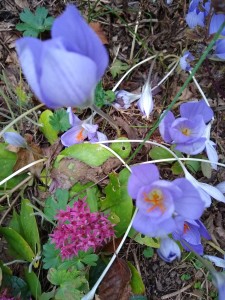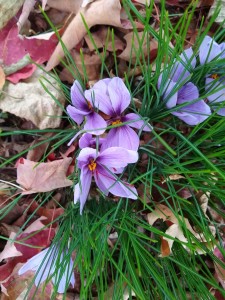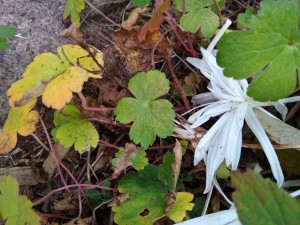 The gardening season at my house is ending as it began, with bright blue and white crocuses dotting the beds. As in the spring, they are poking bravely through the garden rubble that I haven’t yet had time to clean up. People who see them think that climate change has fooled the spring crocuses into appearing at the wrong time. Climate change has affected many things, but these crocuses are meant to bloom in fall, in time to greet the trick-or-treaters.
The gardening season at my house is ending as it began, with bright blue and white crocuses dotting the beds. As in the spring, they are poking bravely through the garden rubble that I haven’t yet had time to clean up. People who see them think that climate change has fooled the spring crocuses into appearing at the wrong time. Climate change has affected many things, but these crocuses are meant to bloom in fall, in time to greet the trick-or-treaters.
In addition to being beautiful, the autumn crocuses are a visual reminder to plant all the spring flowering bulbs that have arrived in recent weeks. Most online vendors ship sometime in October, so I am not the only one with boxes waiting, unopened, in a cool spot. Fortunately, hard freezes haven’t happened yet in my part of the world, so there is time—possibly even plenty of time—to get those bulbs in the ground.
I would love to grow mass quantities of tulips, but the neighborhood deer feast on them when they pop up in the spring. This year, I’ll be planting a small number of the best tulips in big pots on my porch, which is up a flight of stairs from the garden. If the deer learn to climb steps, the game is over.
There is no right or wrong way to plant bulbs, as long as the root side is down and the “shoot” side is up when they are covered with dirt. Some people position bulbs in a naturalistic way, strewing handfuls onto the ground and planting the bulbs where they fall. They use a bulb dibbler or similar tool to dig the planting holes for each bulb. This is wonderful and assures exact placement, but it tends to take forever if you are installing lots of bulbs.
I follow the old gardeners’ rule of planting in odd-numbered lots, so my bulbs go in, five to a single big, round hole. If I am planting little bulbs, like crocuses or grape hyacinths, I expand that number to seven, nine or even eleven. The idea is to produce healthy clumps of blooms in the spring. My neighbor says that daffodils planted this way come up “looking like bouquets”. I think she is right.
Aesthetic considerations aside, this method is the easiest way to plant large quantities of bulbs. It is easier on your back and/or knees than any other method, short of hiring someone else to do the chore.
If you are planting several different kinds of bulbs and you have limited space or want to make things even easier on yourself, use the fruitcake method of planting, which creates layers of bulbs similar to the arrangement of candied fruit in a fruitcake. To do this, assemble your chosen large and small bulbs. Dig a hole that is about ten inches wide and eight inches deep. Plant the biggest bulbs, including large daffodils or hyacinths in a group of five in the bottom of the hole. Cover those with a thin layer of soil. Install smaller daffodils and tulips on top of that soil and cover with another thin soil layer. Finally, plant crocuses, grape hyacinths or any other small bulbs on top of that and finish off with a final layer of about two inches of soil. Don’t worry about the bulbs crowding each other out. The young shoots find their way through the layers at the appropriate time and you will have a satisfactory succession of bloom.
The fruitcake method also works in large containers and optimizes the potential of the available space.
I have been gardening since childhood, and I should know better, but I always order too many bulbs. If I tried to set aside a single block of time to plant them all, I would never get the job done. To assuage the inevitable panic that sets in when the bulb boxes arrive, I plant in increments. If your garden tools are conveniently situated, ten minutes is plenty of time to dig one big hole and install five or seven bulbs. Using bits and corners of time in this way, you can get a large number of bulbs in the ground without too much effort. I frequently plant the last of the bulbs in-between turkey basting and table setting on Thanksgiving. If you are like me and into creative procrastination, incremental bulb planting is also a great way to delay bill paying, cleaning, laundry or any one of a number of household tasks that you may find disagreeable.
If you have forgotten to order or purchase any spring bulbs, don’t worry. They are still available at many nurseries and garden centers. Check in back corners, beyond the Christmas displays that went up the day after Halloween. You will find them there. The selection will be limited, but you can still buy enough bulbs to guarantee some spring color. The prices will probably reflect the merchant’s desperation, as well.
So stop whatever you are doing and find ten minutes to plant some bulbs. You will thank yourself next spring.
